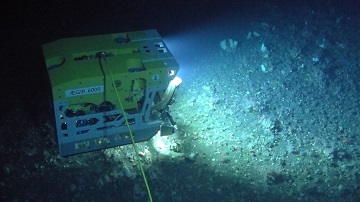Eating Fossils.jpg

A remote operated vehicle (ROV) diving to an Arctic sponge ground. Credit: Det matematisk-naturvitenskaplige fakultet, CC BY-NC 2.0.
In 2016, scientists discovered large fields of sponges atop some volcanic mountains that rise from the bottom of the Arctic Ocean. And that was a big surprise—no one had seen anything like it before. And there didn’t seem to be a way for the sponges to survive—there just wasn’t enough for them to eat.
It turns out that the sponges have found a new way to keep themselves going: eating fossils. Researchers were studying the geology and life of Langseth Ridge, north of Norway and Greenland. The ocean is covered by ice most of the time, so there’s no sunlight to support the tiny organisms that feed sponges and other creatures. And there are no currents or other pathways to bring in nutrients. Even so, sponges covered more than half the surface area atop some of the tallest peaks.
Researchers used robots to gather some sponges. Then they analyzed the sponges and the microscopic organisms inside them that help the sponges process food.
That analysis suggested the sponges had found a new source of food. The sponges sit on beds of tube-worm fossils. The worms inhabited the region for thousands of years before the sponges moved in. When the worms died, their remains became fossilized. But they contained lots of organic compounds—the chemistry of life. The sponges appear to move across the sea bed, scraping up some of the fossils. Their microbes then convert the nutrients to food—keeping the sponges fed in a region where there’s not much to eat.

